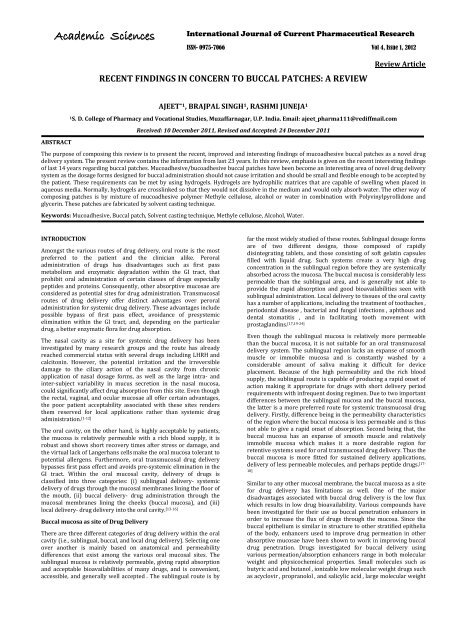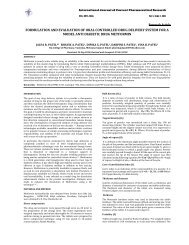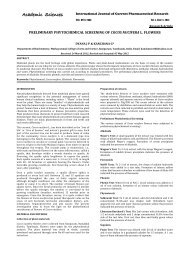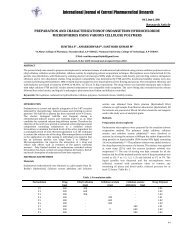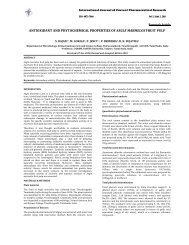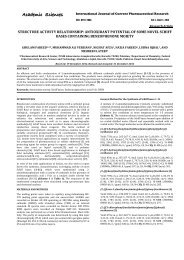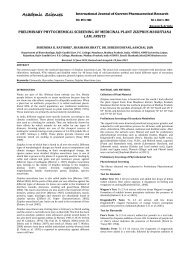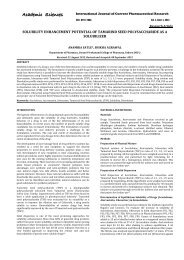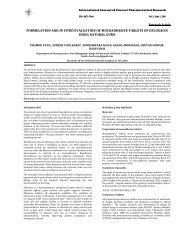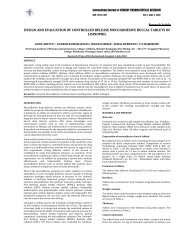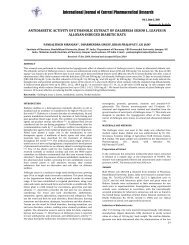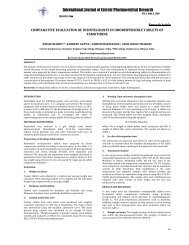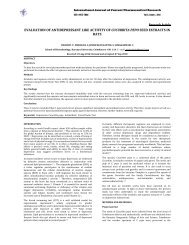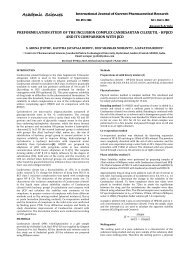recent findings in concern to buccal patches - International Journal ...
recent findings in concern to buccal patches - International Journal ...
recent findings in concern to buccal patches - International Journal ...
Create successful ePaper yourself
Turn your PDF publications into a flip-book with our unique Google optimized e-Paper software.
Academic Sciences<br />
<strong>International</strong> <strong>Journal</strong> of Current Pharmaceutical Research<br />
ISSN- 0975-7066 Vol 4, Issue 1, 2012<br />
RECENT FINDINGS IN CONCERN TO BUCCAL PATCHES: A REVIEW<br />
Review Article<br />
ABSTRACT<br />
AJEET *1 , BRAJPAL SINGH 1 , RASHMI JUNEJA 1<br />
1<br />
S. D. College of Pharmacy and Vocational Studies, Muzaffarnagar, U.P. India. Email: ajeet_pharma111@rediffmail.com<br />
Received: 10 December 2011, Revised and Accepted: 24 December 2011<br />
The purpose of compos<strong>in</strong>g this review is <strong>to</strong> present the <strong>recent</strong>, improved and <strong>in</strong>terest<strong>in</strong>g <strong>f<strong>in</strong>d<strong>in</strong>gs</strong> of mucoadhesive <strong>buccal</strong> <strong>patches</strong> as a novel drug<br />
delivery system. The present review conta<strong>in</strong>s the <strong>in</strong>formation from last 23 years. In this review, emphasis is given on the <strong>recent</strong> <strong>in</strong>terest<strong>in</strong>g <strong>f<strong>in</strong>d<strong>in</strong>gs</strong><br />
of last 14 years regard<strong>in</strong>g <strong>buccal</strong> <strong>patches</strong>. Mucoadhesive/bucoadhesive <strong>buccal</strong> <strong>patches</strong> have been become an <strong>in</strong>terest<strong>in</strong>g area of novel drug delivery<br />
system as the dosage forms designed for <strong>buccal</strong> adm<strong>in</strong>istration should not cause irritation and should be small and flexible enough <strong>to</strong> be accepted by<br />
the patient. These requirements can be met by us<strong>in</strong>g hydrogels. Hydrogels are hydrophilic matrices that are capable of swell<strong>in</strong>g when placed <strong>in</strong><br />
aqueous media. Normally, hydrogels are crossl<strong>in</strong>ked so that they would not dissolve <strong>in</strong> the medium and would only absorb water. The other way of<br />
compos<strong>in</strong>g <strong>patches</strong> is by mixture of mucoadhesive polymer Methyle cellulose, alcohol or water <strong>in</strong> comb<strong>in</strong>ation with Polyv<strong>in</strong>ylpyrollidone and<br />
glycer<strong>in</strong>. These <strong>patches</strong> are fabricated by solvent cast<strong>in</strong>g technique.<br />
Keywords: Mucoadhesive, Buccal patch, Solvent cast<strong>in</strong>g technique, Methyle cellulose, Alcohol, Water.<br />
INTRODUCTION<br />
Amongst the various routes of drug delivery, oral route is the most<br />
preferred <strong>to</strong> the patient and the cl<strong>in</strong>ician alike. Peroral<br />
adm<strong>in</strong>istration of drugs has disadvantages such as first pass<br />
metabolism and enzymatic degradation with<strong>in</strong> the GI tract, that<br />
prohibit oral adm<strong>in</strong>istration of certa<strong>in</strong> classes of drugs especially<br />
peptides and prote<strong>in</strong>s. Consequently, other absorptive mucosae are<br />
considered as potential sites for drug adm<strong>in</strong>istration. Transmucosal<br />
routes of drug delivery offer dist<strong>in</strong>ct advantages over peroral<br />
adm<strong>in</strong>istration for systemic drug delivery. These advantages <strong>in</strong>clude<br />
possible bypass of first pass effect, avoidance of presystemic<br />
elim<strong>in</strong>ation with<strong>in</strong> the GI tract, and, depend<strong>in</strong>g on the particular<br />
drug, a better enzymatic flora for drug absorption.<br />
The nasal cavity as a site for systemic drug delivery has been<br />
<strong>in</strong>vestigated by many research groups and the route has already<br />
reached commercial status with several drugs <strong>in</strong>clud<strong>in</strong>g LHRH and<br />
calci<strong>to</strong>n<strong>in</strong>. However, the potential irritation and the irreversible<br />
damage <strong>to</strong> the ciliary action of the nasal cavity from chronic<br />
application of nasal dosage forms, as well as the large <strong>in</strong>tra- and<br />
<strong>in</strong>ter-subject variability <strong>in</strong> mucus secretion <strong>in</strong> the nasal mucosa,<br />
could significantly affect drug absorption from this site. Even though<br />
the rectal, vag<strong>in</strong>al, and ocular mucosae all offer certa<strong>in</strong> advantages,<br />
the poor patient acceptability associated with these sites renders<br />
them reserved for local applications rather than systemic drug<br />
adm<strong>in</strong>istration. [1-12]<br />
The oral cavity, on the other hand, is highly acceptable by patients,<br />
the mucosa is relatively permeable with a rich blood supply, it is<br />
robust and shows short recovery times after stress or damage, and<br />
the virtual lack of Langerhans cells make the oral mucosa <strong>to</strong>lerant <strong>to</strong><br />
potential allergens. Furthermore, oral transmucosal drug delivery<br />
bypasses first pass effect and avoids pre-systemic elim<strong>in</strong>ation <strong>in</strong> the<br />
GI tract. With<strong>in</strong> the oral mucosal cavity, delivery of drugs is<br />
classified <strong>in</strong><strong>to</strong> three categories: (i) subl<strong>in</strong>gual delivery- systemic<br />
delivery of drugs through the mucosal membranes l<strong>in</strong><strong>in</strong>g the floor of<br />
the mouth, (ii) <strong>buccal</strong> delivery- drug adm<strong>in</strong>istration through the<br />
mucosal membranes l<strong>in</strong><strong>in</strong>g the cheeks (<strong>buccal</strong> mucosa), and (iii)<br />
local delivery- drug delivery <strong>in</strong><strong>to</strong> the oral cavity. [13-16]<br />
Buccal mucosa as site of Drug Delivery<br />
There are three different categories of drug delivery with<strong>in</strong> the oral<br />
cavity (i.e., subl<strong>in</strong>gual, <strong>buccal</strong>, and local drug delivery). Select<strong>in</strong>g one<br />
over another is ma<strong>in</strong>ly based on ana<strong>to</strong>mical and permeability<br />
differences that exist among the various oral mucosal sites. The<br />
subl<strong>in</strong>gual mucosa is relatively permeable, giv<strong>in</strong>g rapid absorption<br />
and acceptable bioavailabilities of many drugs, and is convenient,<br />
accessible, and generally well accepted . The subl<strong>in</strong>gual route is by<br />
far the most widely studied of these routes. Subl<strong>in</strong>gual dosage forms<br />
are of two different designs, those composed of rapidly<br />
dis<strong>in</strong>tegrat<strong>in</strong>g tablets, and those consist<strong>in</strong>g of soft gelat<strong>in</strong> capsules<br />
filled with liquid drug. Such systems create a very high drug<br />
concentration <strong>in</strong> the subl<strong>in</strong>gual region before they are systemically<br />
absorbed across the mucosa. The <strong>buccal</strong> mucosa is considerably less<br />
permeable than the subl<strong>in</strong>gual area, and is generally not able <strong>to</strong><br />
provide the rapid absorption and good bioavailabilities seen with<br />
subl<strong>in</strong>gual adm<strong>in</strong>istration. Local delivery <strong>to</strong> tissues of the oral cavity<br />
has a number of applications, <strong>in</strong>clud<strong>in</strong>g the treatment of <strong>to</strong>othaches ,<br />
periodontal disease , bacterial and fungal <strong>in</strong>fections , aphthous and<br />
dental s<strong>to</strong>matitis , and <strong>in</strong> facilitat<strong>in</strong>g <strong>to</strong>oth movement with<br />
prostagland<strong>in</strong>s. [17,19-24]<br />
Even though the subl<strong>in</strong>gual mucosa is relatively more permeable<br />
than the <strong>buccal</strong> mucosa, it is not suitable for an oral transmucosal<br />
delivery system. The subl<strong>in</strong>gual region lacks an expanse of smooth<br />
muscle or immobile mucosa and is constantly washed by a<br />
considerable amount of saliva mak<strong>in</strong>g it difficult for device<br />
placement. Because of the high permeability and the rich blood<br />
supply, the subl<strong>in</strong>gual route is capable of produc<strong>in</strong>g a rapid onset of<br />
action mak<strong>in</strong>g it appropriate for drugs with short delivery period<br />
requirements with <strong>in</strong>frequent dos<strong>in</strong>g regimen. Due <strong>to</strong> two important<br />
differences between the subl<strong>in</strong>gual mucosa and the <strong>buccal</strong> mucosa,<br />
the latter is a more preferred route for systemic transmucosal drug<br />
delivery. Firstly, difference be<strong>in</strong>g <strong>in</strong> the permeability characteristics<br />
of the region where the <strong>buccal</strong> mucosa is less permeable and is thus<br />
not able <strong>to</strong> give a rapid onset of absorption. Second be<strong>in</strong>g that, the<br />
<strong>buccal</strong> mucosa has an expanse of smooth muscle and relatively<br />
immobile mucosa which makes it a more desirable region for<br />
retentive systems used for oral transmucosal drug delivery. Thus the<br />
<strong>buccal</strong> mucosa is more fitted for susta<strong>in</strong>ed delivery applications,<br />
delivery of less permeable molecules, and perhaps peptide drugs. [17-<br />
18]<br />
Similar <strong>to</strong> any other mucosal membrane, the <strong>buccal</strong> mucosa as a site<br />
for drug delivery has limitations as well. One of the major<br />
disadvantages associated with <strong>buccal</strong> drug delivery is the low flux<br />
which results <strong>in</strong> low drug bioavailability. Various compounds have<br />
been <strong>in</strong>vestigated for their use as <strong>buccal</strong> penetration enhancers <strong>in</strong><br />
order <strong>to</strong> <strong>in</strong>crease the flux of drugs through the mucosa. S<strong>in</strong>ce the<br />
<strong>buccal</strong> epithelium is similar <strong>in</strong> structure <strong>to</strong> other stratified epithelia<br />
of the body, enhancers used <strong>to</strong> improve drug permeation <strong>in</strong> other<br />
absorptive mucosae have been shown <strong>to</strong> work <strong>in</strong> improv<strong>in</strong>g <strong>buccal</strong><br />
drug penetration. Drugs <strong>in</strong>vestigated for <strong>buccal</strong> delivery us<strong>in</strong>g<br />
various permeation/absorption enhancers range <strong>in</strong> both molecular<br />
weight and physicochemical properties. Small molecules such as<br />
butyric acid and butanol , ionizable low molecular weight drugs such<br />
as acyclovir , propranolol , and salicylic acid , large molecular weight
Ajeet et al.<br />
Int J Curr Pharm Res, Vol 4, Issue 1, 12-17<br />
hydrophilic polymers such as dextrans , and a variety of peptides<br />
<strong>in</strong>clud<strong>in</strong>g octreotide, leut<strong>in</strong>iz<strong>in</strong>g hormone releas<strong>in</strong>g hormone<br />
(LHRH) , <strong>in</strong>sul<strong>in</strong> , and a-<strong>in</strong>terferon have all been studied. [25-34]<br />
A series of studies on <strong>buccal</strong> permeation of buserel<strong>in</strong> and fluoresce<strong>in</strong><br />
isothiocyanate (FITC) labelled dextrans reported the enhanc<strong>in</strong>g<br />
effects of di- and tri-hydroxy bile salts on <strong>buccal</strong> penetration. Their<br />
results showed that <strong>in</strong> the presence of the bile salts, the permeability<br />
of porc<strong>in</strong>e <strong>buccal</strong> mucosa <strong>to</strong> FITC <strong>in</strong>creased by a 100-200 fold<br />
compared <strong>to</strong> FITC alone. The mechanism of penetration<br />
enhancement of FITC-labelled dextrans by sodium glycocholate<br />
(SGC) was shown <strong>to</strong> be concentration dependent. Below 10 mM SGC,<br />
<strong>buccal</strong> permeation was <strong>in</strong>creased by <strong>in</strong>creas<strong>in</strong>g the <strong>in</strong>tercellular<br />
transport and at 10 mM and higher concentrations by open<strong>in</strong>g up a<br />
transcellular route. Gandhi and Rob<strong>in</strong>son <strong>in</strong>vestigated the<br />
mechanisms of penetration enhancement of trans<strong>buccal</strong> delivery of<br />
salicylic acid. They used sodium deoxycholate and sodium lauryl<br />
sulfate as penetration enhancers, both of which were found <strong>to</strong><br />
<strong>in</strong>crease the permeability of salicylic acid across rabbit <strong>buccal</strong><br />
mucosa. Their results also supported that the superficial layers and<br />
prote<strong>in</strong> doma<strong>in</strong> of the epithelium may be responsible for<br />
ma<strong>in</strong>ta<strong>in</strong><strong>in</strong>g the barrier function of the <strong>buccal</strong> mucosa. [35-38]<br />
Buccal Drug Delivery Systems<br />
Other than the low flux associated with <strong>buccal</strong> mucosal delivery, a<br />
major limitation of the <strong>buccal</strong> route of adm<strong>in</strong>istration is the lack of<br />
dosage form retention at the site of absorption. Consequently,<br />
bioadhesive polymers have extensively been employed <strong>in</strong> <strong>buccal</strong><br />
drug delivery systems. Bioadhesive polymers are def<strong>in</strong>ed as<br />
polymers that can adhere on<strong>to</strong> a biological substrate. The term<br />
mucoadhesion is applied when the substrate is mucosal tissue.<br />
Polymers which can adhere <strong>to</strong> either hard or soft tissue have been<br />
used for many years <strong>in</strong> surgery and dentistry. Diverse classes of<br />
polymers have been <strong>in</strong>vestigated for their potential use as<br />
mucoadhesives. These <strong>in</strong>clude synthetic polymers such as<br />
monomeric a cyanoacrylate , polyacrylic acid , hydroxypropyl<br />
methylcellulose , and poly methacrylate derivatives as well as<br />
naturally occurr<strong>in</strong>g polymers such as hyaluronic acid and chi<strong>to</strong>san .<br />
Other synthetic polymers such as polyurethanes, epoxy res<strong>in</strong>s,<br />
polystyrene, and natural-product cement have also been extensively<br />
<strong>in</strong>vestigated. [21,39-44]<br />
In general, dosage forms designed for <strong>buccal</strong> adm<strong>in</strong>istration should<br />
not cause irritation and should be small and flexible enough <strong>to</strong> be<br />
accepted by the patient. These requirements can be met by us<strong>in</strong>g<br />
hydrogels. Hydrogels are hydrophilic matrices that are capable of<br />
swell<strong>in</strong>g when placed <strong>in</strong> aqueous media . Normally, hydrogels are<br />
crossl<strong>in</strong>ked so that they would not dissolve <strong>in</strong> the medium and<br />
would only absorb water. When drugs are loaded <strong>in</strong><strong>to</strong> these<br />
hydrogels, as water is absorbed <strong>in</strong><strong>to</strong> the matrix, cha<strong>in</strong> relaxation<br />
occurs and drug molecules are released through the spaces or<br />
channels with<strong>in</strong> the hydrogel network. In a more broad mean<strong>in</strong>g of<br />
the term, hydrogels would also <strong>in</strong>clude water-soluble matrices that<br />
are capable of swell<strong>in</strong>g <strong>in</strong> aqueous media, these <strong>in</strong>clude natural<br />
gums and cellulose derivatives. These ‘pseudo-hydrogels’ swell<br />
<strong>in</strong>f<strong>in</strong>itely and the component molecules dissolve from the surface of<br />
the matrix. Drug release would then occur through the spaces or<br />
channels with<strong>in</strong> the network as well as through the dissolution<br />
and/or the dis<strong>in</strong>tegration of the matrix. The use of hydrogels as<br />
adhesive preparations for transmucosal drug delivery has acquired<br />
considerable attention <strong>in</strong> <strong>recent</strong> years. [44]<br />
Ajeet et. al. (2011) has designed and evaluated mucoadhesive<br />
placebo <strong>buccal</strong> device. These <strong>patches</strong> are composed of mixture of<br />
mucoadhesive polymer Methyle cellulose and water <strong>in</strong> comb<strong>in</strong>ation<br />
with Polyv<strong>in</strong>ylpyrollidone and glycer<strong>in</strong>. The <strong>patches</strong> were fabricated<br />
by solvent cast<strong>in</strong>g technique and were evaluated for its physical<br />
properties. The <strong>patches</strong> were evaluated for film weight uniformity,<br />
thickness, swell<strong>in</strong>g <strong>in</strong>dex, surface pH, mucoadhesive time and<br />
fold<strong>in</strong>g endurance. A comb<strong>in</strong>ation of Methyle cellulose with<br />
Polyv<strong>in</strong>ylpyrollidone K30, glycer<strong>in</strong> with water as solvent gives<br />
promis<strong>in</strong>g results. [45]<br />
Parikj Bhavik Anjankumar (2011) has designed and evaluated<br />
mucoadhesive bi-layered <strong>buccal</strong> devices compris<strong>in</strong>g a drug<br />
conta<strong>in</strong><strong>in</strong>g mucoadhesive layer and a drug free back<strong>in</strong>g membrane.<br />
Bilam<strong>in</strong>ated films composed of mixture of drug (Valsartan) and<br />
chi<strong>to</strong>san, with hydroxyl- propylmethylcellulose (15 cps) and back<strong>in</strong>g<br />
layer (ethyl cellulose). Films were fabricated by solvent cast<strong>in</strong>g<br />
technique and were evaluated for thickness, drug content<br />
uniformity, bio-adhesion strength, percent, swell<strong>in</strong>g <strong>in</strong>dex, fold<strong>in</strong>g<br />
endurance and <strong>in</strong> vitro drug release. A comb<strong>in</strong>ation of chi<strong>to</strong>san and<br />
hydroxylpropylmethylcellulose (1:1) us<strong>in</strong>g propylene glycol (50%<br />
by weight of polymer) as plasticizer gave promis<strong>in</strong>g results. The<br />
optimized film exhibited an In vitro drug release of approximately<br />
90% <strong>in</strong> 5 hrs along with satisfac<strong>to</strong>ry bio-adhesive strength [46] .<br />
Rohit Chaudhary et. al. (2010) has designed and evaluated<br />
mucoadhesive bilayered <strong>buccal</strong> devices compris<strong>in</strong>g a drug<br />
conta<strong>in</strong><strong>in</strong>g mucoadhesive layer and a drug free back<strong>in</strong>g membrane.<br />
Bilam<strong>in</strong>atd <strong>patches</strong> composed of mixture of drug (Methotrexate) and<br />
sodium alg<strong>in</strong>ate alone or <strong>in</strong> comb<strong>in</strong>ation with sodium carboxy<br />
methylcellulose ,Polyv<strong>in</strong>ylpyrrolid<strong>in</strong>e and carbopol 934 and back<strong>in</strong>g<br />
membrane (Ethyl cellulose).The <strong>patches</strong> were fabricated by solvent<br />
cast<strong>in</strong>g technique and were evaluated for In-Vitro and Ex-Vivo drug<br />
release. The <strong>patches</strong> were evaluated for film weight uniformity,<br />
thickness, swell<strong>in</strong>g <strong>in</strong>dex, surface pH, mucoadhesive strength and<br />
mucoadhesive time and fold<strong>in</strong>g endurance. A comb<strong>in</strong>ation of sodium<br />
alg<strong>in</strong>ate with carbopol-934 and glycerol as plasticizer gives<br />
promis<strong>in</strong>g results. The optimized patch exhibit an <strong>in</strong> vitro release of<br />
82% through cellophane membrane and 70.78 % through <strong>buccal</strong><br />
mucosa with satisfac<strong>to</strong>ry mucoadhesive strength and mucoadhesive<br />
time. [47]<br />
G.A. Khairnar and F. J. Sayyad (2010) reviewed the highlights of<br />
development of mucoadhesive polymers <strong>in</strong> <strong>buccal</strong> drug delivery.<br />
Buccal delivery of the desired drug us<strong>in</strong>g mucoadhesive polymers<br />
has been the subject of <strong>in</strong>terest s<strong>in</strong>ce the early 1980s. Advantages<br />
associated with <strong>buccal</strong> drug delivery have rendered this route of<br />
adm<strong>in</strong>istration useful for a variety of drugs. This article covers the<br />
ana<strong>to</strong>my of oral mucosa, mechanism of drug permeation,<br />
characteristics and properties of the desired polymers, new<br />
generation of the mucoadhesive polymers [48] .<br />
A polymeric film composed of Carbopol, Poloxamer and<br />
hydroxypropyl methylcellulose was prepared by Myung Kwan Chun<br />
et. al. (2010) <strong>to</strong> develop a <strong>buccal</strong> patch and the effects of<br />
composition of the film on adhesion time, swell<strong>in</strong>g ratio, and<br />
dissolution of the film were studied. The effects of plasticizers or<br />
penetration enhancers on the release of triamc<strong>in</strong>olone ace<strong>to</strong>nide<br />
(TAA) were also studied. The hydrogen bond<strong>in</strong>g between Carbopol<br />
and Poloxamer played important role <strong>in</strong> reduc<strong>in</strong>g swell<strong>in</strong>g ratio and<br />
dissolution rate of polymer film and <strong>in</strong>creas<strong>in</strong>g adhesion time. The<br />
swell<strong>in</strong>g ratio of the composite film was significantly reduced and<br />
the adhesion time was <strong>in</strong>creased when compared with Carbopol<br />
film. As the ratio of Poloxamer <strong>to</strong> hydroxypropyl methylcellulose<br />
<strong>in</strong>creased from 0/66 <strong>to</strong> 33/33, the release rate of TAA decreased.<br />
However, no further significant decrease of release rate was<br />
observed beyond the ratio of 33/33. The release rate of TAA <strong>in</strong> the<br />
polymeric film conta<strong>in</strong><strong>in</strong>g polyethylene glycol 400, a plasticizer,<br />
showed the highest release rate followed by triethyl citrate, and<br />
cas<strong>to</strong>r oil. The release rate of TAA from the polymeric film<br />
conta<strong>in</strong><strong>in</strong>g permeation enhancers was slower than that from the<br />
control without enhancers. Therefore, these observations <strong>in</strong>dicated<br />
that a preparation of a <strong>buccal</strong> patch is feasible with the polymeric<br />
film composed of Cabopol, Poloxamer and hydropropyl<br />
methylcellulose. [49]<br />
Buccal <strong>patches</strong> for the delivery of atenolol us<strong>in</strong>g sodium alg<strong>in</strong>ate<br />
with various hydrophilic polymers like carbopol 934 P, sodium<br />
carboxymethyl cellulose, and hydroxypropyl methylcellulose <strong>in</strong><br />
various proportions and comb<strong>in</strong>ations were fabricated by Surya<br />
Adhikari et. al. (2010) us<strong>in</strong>g solvent cast<strong>in</strong>g technique. Various<br />
physicomechanical parameters like weight variation, thickness,<br />
fold<strong>in</strong>g endurance, drug content, moisture content, moisture<br />
absorption, and various ex vivo mucoadhesion parameters like<br />
mucoadhesive strength, force of adhesion, and bond strength were<br />
evaluated. An <strong>in</strong> vitro drug release study was designed, and it was<br />
carried out us<strong>in</strong>g commercial semipermeable membrane. All these<br />
fabricated <strong>patches</strong> were susta<strong>in</strong>ed for 24 h and obeyed first-order<br />
13
Ajeet et al.<br />
Int J Curr Pharm Res, Vol 4, Issue 1, 12-17<br />
release k<strong>in</strong>etics. Ex vivo drug permeation study was also performed<br />
us<strong>in</strong>g porc<strong>in</strong>e <strong>buccal</strong> mucosa, and various drug permeation<br />
parameters like flux and lag time were determ<strong>in</strong>ed. [50]<br />
Bilayer nicot<strong>in</strong>e mucoadhesive <strong>patches</strong> were prepared and<br />
evaluated by Rana Abu Huwaij (2010) <strong>to</strong> determ<strong>in</strong>e the feasibility of<br />
the formulation as a nicot<strong>in</strong>e replacement product <strong>to</strong> aid <strong>in</strong> smok<strong>in</strong>g<br />
cessation. Nicot<strong>in</strong>e <strong>patches</strong> were prepared us<strong>in</strong>g xanthan gum or<br />
carbopol 934 as a mucoadhesive polymers and ethyl cellulose as a<br />
back<strong>in</strong>g layer. The <strong>patches</strong> were evaluated for their thickness,<br />
weight and content uniformity, swell<strong>in</strong>g behavior, drug–polymers<br />
<strong>in</strong>teraction, adhesive properties, and drug release. The<br />
physicochemical <strong>in</strong>teractions between nicot<strong>in</strong>e and the polymers<br />
were <strong>in</strong>vestigated by Fourier transform <strong>in</strong>frared (FTIR)<br />
spectroscopy. Mucoadhesion was assessed us<strong>in</strong>g two-arm balance<br />
method, and the <strong>in</strong> vitro release was studied us<strong>in</strong>g the Franz cell.<br />
FTIR revealed that there was an acid base <strong>in</strong>teraction between<br />
nicot<strong>in</strong>e and carbopol as well as nicot<strong>in</strong>e and xanthan. Interest<strong>in</strong>gly,<br />
the mucoadhesion and <strong>in</strong> vitro release studies <strong>in</strong>dicated that this<br />
<strong>in</strong>teraction was strong between the drug and carbopol whereas it<br />
was weak between the drug and xanthan. Load<strong>in</strong>g nicot<strong>in</strong>e<br />
concentration <strong>to</strong> non-medicated <strong>patches</strong> showed a significant<br />
decrease <strong>in</strong> the mucoadhesion strength of carbopol <strong>patches</strong> and no<br />
significant effect on the mucoadhesion strength of xanthan <strong>patches</strong>.<br />
In vitro release studies of the xanthan <strong>patches</strong> showed a reasonable<br />
fast <strong>in</strong>itial release profile followed by controlled drug release over a<br />
10-h period. [51]<br />
The aim of Gazzi Shanker et. al. (2010) was <strong>concern</strong>ed with<br />
formulation and evaluation of bioadhesive <strong>buccal</strong> drug delivery of<br />
tizanid<strong>in</strong>e hydrochloride tablets, which is extensively metabolized<br />
by liver. The tablets were prepared by direct compression us<strong>in</strong>g<br />
bioadhesive polymers such as hydroxylpropyl methylcellulose K4M,<br />
sodium carboxymethyl cellulose alone, and a comb<strong>in</strong>ation of these<br />
two polymers. In order <strong>to</strong> improve the permeation of drug, different<br />
permeation enhancers like beta-cyclodextr<strong>in</strong> (β-CD), hydroxylpropyl<br />
beta-cyclodextr<strong>in</strong> (HP-β-CD), and sodium deoxycholate (SDC) were<br />
added <strong>to</strong> the formulations. The β-CD and HP-β-CD were taken <strong>in</strong> 1:1<br />
molar ratio <strong>to</strong> drug <strong>in</strong> formulations. Bioadhesion strength, ex vivo<br />
residence time, swell<strong>in</strong>g, and <strong>in</strong> vitro dissolution studies and ex vivo<br />
permeation studies were performed. In vitro release of optimized<br />
bioadhesive <strong>buccal</strong> tablet was found <strong>to</strong> be non-Fickian. SDC was<br />
taken <strong>in</strong> 1%, 2%, and 3% w/w of the <strong>to</strong>tal tablet weight. Stability<br />
studies <strong>in</strong> natural saliva <strong>in</strong>dicated that optimized formulation has<br />
good stability <strong>in</strong> human saliva. In vivo mucoadhesive behavior of<br />
optimized formulation was performed <strong>in</strong> five healthy male human<br />
volunteers and subjective parameters were evaluated. [52]<br />
Deelip Derle et. al. (2009) has formulated and evaluated<br />
mucoadhesive bi-layer <strong>buccal</strong> tablets of propranolol hydrochloride<br />
tablets us<strong>in</strong>g the bioadhesive polymers such as sodium alg<strong>in</strong>ate and<br />
carbopol 971 P along with ethyl cellulose as an impermeable<br />
back<strong>in</strong>g layer. The tablets were evaluated for weight variation,<br />
thickness, hardness, friability, surface pH, mucoadhesive strength,<br />
swell<strong>in</strong>g <strong>in</strong>dex, <strong>in</strong> vitro drug release. Tablets conta<strong>in</strong><strong>in</strong>g sodium<br />
alg<strong>in</strong>ate and carbopol 971 P <strong>in</strong> the ratio of 5:1 showed the maximum<br />
percentage of <strong>in</strong> vitro drug release without dis<strong>in</strong>tegration <strong>in</strong> 12<br />
hours. The swell<strong>in</strong>g <strong>in</strong>dex was proportional <strong>to</strong> sodium alg<strong>in</strong>ate<br />
content and <strong>in</strong>versely proportional <strong>to</strong> carbopol 971 P content. The<br />
surface pH of all tablets was found <strong>to</strong> be satisfac<strong>to</strong>ry, close <strong>to</strong> neutral<br />
pH; hence, no irritation would observe with these tablets. The<br />
mechanism of drug release was found <strong>to</strong> be zero-order k<strong>in</strong>etics. [53]<br />
Subhash V. Deshmane et. al. (2009) have the objective of present<br />
work was <strong>to</strong> characterize the effect of chi<strong>to</strong>san with PVP K-30 on<br />
water soluble drug by prepar<strong>in</strong>g mucoadhesive <strong>buccal</strong> patch. Each<br />
formulated batch was subjected <strong>to</strong> various evaluation parameters.<br />
The swell<strong>in</strong>g percentage was found <strong>to</strong> be function of solubility of<br />
drug and PVP K-30. The mucoadhesive strength, vapour<br />
transmission and <strong>in</strong>-vitro released of water soluble drug through<br />
water <strong>in</strong>soluble chi<strong>to</strong>san base matrix were found satisfac<strong>to</strong>rily. The<br />
physical appearance of <strong>buccal</strong> patch was exam<strong>in</strong>ed by scann<strong>in</strong>g<br />
electron microscopy. The released k<strong>in</strong>etic model best <strong>to</strong> fit for the<br />
optimized batch was Hixson Crowell, <strong>in</strong>dicat<strong>in</strong>g that the drug release<br />
from systems <strong>in</strong> which there is a change <strong>in</strong> the surface area and the<br />
diameter of particles present <strong>in</strong> dosage form [54] .<br />
Chandra Sekhar Kolli et. al. (2008) have the aim of this <strong>in</strong>vestigation<br />
was <strong>to</strong> develop and evaluate mucoadhesive <strong>buccal</strong> <strong>patches</strong> of<br />
prochlorperaz<strong>in</strong>e (PCPZ). Permeation of PCPZ was calculated <strong>in</strong><br />
vitro us<strong>in</strong>g porc<strong>in</strong>e <strong>buccal</strong> membrane. Buccal formulations were<br />
developed by solvent-cast<strong>in</strong>g technique us<strong>in</strong>g hydroxy propylmethyl<br />
cellulose (HPMC) as mucoadhesive polymer. The <strong>patches</strong> were<br />
evaluated for <strong>in</strong> vitro release, moisture absorption and mechanical<br />
properties. The optimized formulation, based on <strong>in</strong> vitro release and<br />
moisture absorption studies, was subjected for bioadhesion studies<br />
us<strong>in</strong>g porc<strong>in</strong>e <strong>buccal</strong> membrane. In vitro flux of PCPZ was calculated<br />
<strong>to</strong> be 2.14 ± 0.01 µg. h –1 .cm –2 and <strong>buccal</strong> absorption was also<br />
demonstrated <strong>in</strong> vivo <strong>in</strong> human volunteers. In vitro drug release and<br />
moisture absorbed was governed by HPMC content. Increas<strong>in</strong>g<br />
concentration of HPMC delayed the drug release. All formulations<br />
followed Zero order release k<strong>in</strong>etics whereas the release pattern<br />
was non-Fickian. The mechanical properties, tensile strength (10.28<br />
± 2.27 kg mm –2) and elongation at break reveal that the<br />
formulations were found <strong>to</strong> be strong but not brittle. The peak<br />
detachment force and work of adhesion for formulation were 0.68 ±<br />
0.15 N and 0.14 ± 0.08 mJ, respectively. The results <strong>in</strong>dicate that<br />
suitable bioadhesive <strong>buccal</strong> <strong>patches</strong> of PCPZ with desired<br />
permeability and suitable mechanical properties could be<br />
prepared. [55]<br />
Supriya Sidhaye et. al. (2008) have the purpose of this study was <strong>to</strong><br />
develop and optimize formulations of mucoadhesive bilayered<br />
<strong>buccal</strong> <strong>patches</strong> of sumatriptan succ<strong>in</strong>ate us<strong>in</strong>g chi<strong>to</strong>san as the base<br />
matrix. The <strong>patches</strong> were prepared by the solvent cast<strong>in</strong>g method.<br />
Gelat<strong>in</strong> and polyv<strong>in</strong>yl pyrrolidone (PVP) K30 were <strong>in</strong>corporated <strong>in</strong><strong>to</strong><br />
the <strong>patches</strong>, <strong>to</strong> improve the film properties of the <strong>patches</strong>. The<br />
<strong>patches</strong> were found <strong>to</strong> be smooth <strong>in</strong> appearance, uniform <strong>in</strong><br />
thickness, weight, and drug content; showed good mucoadhesive<br />
strength; and good fold<strong>in</strong>g endurance. A 3 2 full fac<strong>to</strong>rial design was<br />
employed <strong>to</strong> study the effect of <strong>in</strong>dependent variables viz. levels of<br />
chi<strong>to</strong>san and PVP K30, which significantly <strong>in</strong>fluenced characteristics<br />
like swell<strong>in</strong>g <strong>in</strong>dex, <strong>in</strong>-vitro mucoadhesive strength, <strong>in</strong> vitro drug<br />
release, and <strong>in</strong>-vitro residence time. Different penetration enhancers<br />
were tried <strong>to</strong> improve the permeation of sumatriptan succ<strong>in</strong>ate<br />
through <strong>buccal</strong> mucosa. Formulation conta<strong>in</strong><strong>in</strong>g 3% dimethyl<br />
sulfoxide showed good permeation of sumatriptan succ<strong>in</strong>ate<br />
through mucosa. His<strong>to</strong>pathological studies revealed no <strong>buccal</strong><br />
mucosal damage. It can be concluded that <strong>buccal</strong> route can be one of<br />
the alternatives available for adm<strong>in</strong>istration of sumatriptan<br />
succ<strong>in</strong>ate. [56]<br />
A <strong>buccal</strong> patch for systemic adm<strong>in</strong>istration of carvedilol <strong>in</strong> the oral<br />
cavity has been developed by Y. Vamshi Vishnu et. al. (2007) us<strong>in</strong>g<br />
two different mucoadhesive polymers. The formulations were tested<br />
for <strong>in</strong> vitro drug permeation studies, <strong>buccal</strong> absorption test, <strong>in</strong> vitro<br />
release studies, moisture absorption studies and <strong>in</strong> vitro<br />
bioadhesion studies. The physicochemical <strong>in</strong>teractions between<br />
carvedilol and polymers were <strong>in</strong>vestigated by Fourier transform<br />
<strong>in</strong>frared (FTIR) Spectroscopy. Accord<strong>in</strong>g <strong>to</strong> FTIR the drug did not<br />
show any evidence of an <strong>in</strong>teraction with the polymers used and was<br />
present <strong>in</strong> an unchanged state. XRD studies reveal that the drug is <strong>in</strong><br />
crystall<strong>in</strong>e state <strong>in</strong> the polymer matrix. The results <strong>in</strong>dicate that<br />
suitable bioadhesive <strong>buccal</strong> <strong>patches</strong> with desired permeability could<br />
be prepared. Bioavailability studies <strong>in</strong> healthy pigs reveal that<br />
carvedilol has got good <strong>buccal</strong> absorption. The bioavailability of<br />
carvedilol from <strong>buccal</strong> <strong>patches</strong> has <strong>in</strong>creased 2.29 folds when<br />
compared <strong>to</strong> that of oral solution. The formulation shows 84.85 +<br />
0.089% release and 38.69 + 6.61% permeated through porc<strong>in</strong>e<br />
<strong>buccal</strong> membrane <strong>in</strong> 4 hr. The basic pharmacok<strong>in</strong>etic parameters<br />
like the C max , T max and AUC <strong>to</strong>tal were calculated and showed<br />
statistically significant difference (P
Ajeet et al.<br />
Int J Curr Pharm Res, Vol 4, Issue 1, 12-17<br />
content uniformity, fold<strong>in</strong>g endurance, ex vivo mucoadhesion<br />
strength, ex vivo mucoadhesion time, surface pH, <strong>in</strong> vitro drug<br />
release, and <strong>in</strong> vitro <strong>buccal</strong> permeation study. Patches exhibited<br />
controlled release for a period of 7 h. The mechanism of drug release<br />
was found <strong>to</strong> be non-Fickian diffusion and followed the first-order<br />
k<strong>in</strong>etics. Incorporation of PVP K-30 generally enhanced the release<br />
rate. Swell<strong>in</strong>g <strong>in</strong>dex was proportional <strong>to</strong> the concentration of PVP K-<br />
30. Optimized <strong>patches</strong> showed satisfac<strong>to</strong>ry bioadhesive strength of<br />
9.6 ± 2.0 g, and ex vivo mucoadhesion time of 272 m<strong>in</strong>utes. The<br />
surface pH of all <strong>patches</strong> was between 5.7 and 6.3 and hence <strong>patches</strong><br />
should not cause irritation <strong>in</strong> the <strong>buccal</strong> cavity. Patches conta<strong>in</strong><strong>in</strong>g<br />
10 mg of drug had higher bioadhesive strength with susta<strong>in</strong>ed drug<br />
release as compared <strong>to</strong> <strong>patches</strong> conta<strong>in</strong><strong>in</strong>g 20 mg of drug. Good<br />
correlation was observed between the <strong>in</strong> vitro drug release and <strong>in</strong><br />
vitro drug permeation with a correlation coefficient of 0.9364.<br />
Stability study of optimized <strong>patches</strong> was done <strong>in</strong> human saliva and it<br />
was found that both drug and <strong>buccal</strong> <strong>patches</strong> were stable. [58]<br />
Vishnu Patel et. al. (2007) have developed formulations and<br />
systematically evaluated <strong>in</strong> vitro performances of buccoadhesive<br />
<strong>patches</strong> of propranolol hydrochloride us<strong>in</strong>g the hydrophobic<br />
polymer Eudragit L-100 as the base matrix. The hydrophilic<br />
polymers Carbopol 934 and polyv<strong>in</strong>yl pyrrolidone (PVP) K30 were<br />
<strong>in</strong>corporated <strong>in</strong><strong>to</strong> the Eudragit <strong>patches</strong>, <strong>to</strong> provide the <strong>patches</strong> with<br />
bioadhesive properties and <strong>to</strong> modify the rate of drug release. The<br />
<strong>patches</strong>, which were prepared by the solvent cast<strong>in</strong>g method, were<br />
smooth and elegant <strong>in</strong> appearance; were uniform <strong>in</strong> thickness,<br />
weight, and drug content; showed no visible cracks; and showed<br />
good fold<strong>in</strong>g endurance. A 3 2 full fac<strong>to</strong>rial design was employed <strong>to</strong><br />
study the effect of <strong>in</strong>dependent variables like hydrophilic polymers<br />
Carbopol 934 and PVP K30, which significantly <strong>in</strong>fluenced<br />
characteristics like swell<strong>in</strong>g <strong>in</strong>dex, ex vivo mucoadhesive strength, <strong>in</strong><br />
vitro drug release, and ex vivo residence time. A stability study of<br />
optimized Eudragit <strong>patches</strong> was done <strong>in</strong> natural human saliva; it was<br />
found that both drug and <strong>buccal</strong> <strong>patches</strong> were stable <strong>in</strong> human<br />
saliva. It can be concluded that the present <strong>buccal</strong> formulation can<br />
be an ideal system <strong>to</strong> improve the bioavailability of the drug by<br />
avoid<strong>in</strong>g hepatic first-pass metabolism. [59]<br />
A novel delivery system has been developed by Marta Corbonits et.<br />
al (2004) for tes<strong>to</strong>sterone replacement. This formulation, COL-1621<br />
(Striant), a tes<strong>to</strong>sterone-conta<strong>in</strong><strong>in</strong>g <strong>buccal</strong> mucoadhesive system,<br />
has been shown <strong>in</strong> prelim<strong>in</strong>ary studies <strong>to</strong> replace tes<strong>to</strong>sterone at<br />
physiological levels when used twice daily. Therefore, the current<br />
study compared the steady-state pharmacok<strong>in</strong>etics and <strong>to</strong>lerability<br />
of the <strong>buccal</strong> system with a tes<strong>to</strong>sterone-conta<strong>in</strong><strong>in</strong>g sk<strong>in</strong> patch <strong>in</strong> an<br />
<strong>in</strong>ternational multicenter study of a group of hypogonadal men.<br />
Sixty-six patients were randomized <strong>in</strong><strong>to</strong> two groups; one applied the<br />
<strong>buccal</strong> system twice daily, whereas the other applied the<br />
transdermal patch daily. Serum <strong>to</strong>tal tes<strong>to</strong>sterone and<br />
dihydrotes<strong>to</strong>sterone concentrations were measured over the last 24<br />
h of the study. Pharmacok<strong>in</strong>etic parameters for each formulation<br />
were calculated, and the two groups were compared. The <strong>to</strong>lerability<br />
of both formulations was also evaluated.<br />
Thirty-three patients were treated with the <strong>buccal</strong> preparation, and<br />
34 were treated with the transdermal patch. The average serum<br />
tes<strong>to</strong>sterone concentration over 24 h showed a mean of 18.74<br />
nmol/liter (SD =; 5.90) <strong>in</strong> the <strong>buccal</strong> system group and 12.15<br />
nmol/liter (SD =; 5.55) <strong>in</strong> the transdermal patch group (P < 0.01). Of<br />
the patients treated with the <strong>buccal</strong> system, 97% had average<br />
steady-state tes<strong>to</strong>sterone concentrations with<strong>in</strong> the physiological<br />
range (10.41–36.44 nmol/liter), whereas only 56% of the<br />
transdermal patch patients achieved physiological <strong>to</strong>tal tes<strong>to</strong>sterone<br />
concentrations (P < 0.001 between groups). Tes<strong>to</strong>sterone<br />
concentrations were with<strong>in</strong> the physiological range <strong>in</strong> the <strong>buccal</strong><br />
system group for a significantly greater portion of the 24-h<br />
treatment period than <strong>in</strong> the transdermal patch group (mean, 84.9%<br />
vs. 54.9%; P < 0.001). Tes<strong>to</strong>sterone/dihydrotes<strong>to</strong>sterone ratios were<br />
physiological and similar <strong>in</strong> both groups. Few patients experienced<br />
major adverse effects from either treatment. No significant local<br />
<strong>to</strong>lerability problems were noted with the <strong>buccal</strong> system, other than<br />
a s<strong>in</strong>gle patient withdrawal. We conclude that this <strong>buccal</strong> system is<br />
superior <strong>to</strong> the transdermal patch <strong>in</strong> achiev<strong>in</strong>g tes<strong>to</strong>sterone<br />
concentrations with<strong>in</strong> the normal range. It may, therefore, be a<br />
valuable addition <strong>to</strong> the range of choices for tes<strong>to</strong>sterone<br />
replacement therapy. [60]<br />
Mucoadhesive <strong>patches</strong> for delivery of salbutamol sulphate were<br />
prepared by L. Panigrahi et. al. (2004) us<strong>in</strong>g polyv<strong>in</strong>yl alcohol,<br />
hydroxypropylmethyl cellulose and chi<strong>to</strong>san. Mechanical property,<br />
swell<strong>in</strong>g and bioadhesive characteristics were detem<strong>in</strong>ed for both<br />
pla<strong>in</strong> and medicated <strong>patches</strong>. Mechanical properties were<br />
determ<strong>in</strong>ed <strong>in</strong> presence of carbopol and polyv<strong>in</strong>ylpyrrolidone. The<br />
results showed an <strong>in</strong>crease <strong>in</strong> swell<strong>in</strong>g after addition of salbutamol<br />
sulphate <strong>to</strong> the pla<strong>in</strong> formulation. This was attributed that the<br />
salbutamol sulphate modifies the way water is bound <strong>to</strong> or taken by<br />
the polymer. A decrease <strong>in</strong> residual time was observed for polyv<strong>in</strong>yl<br />
alcohol and ci<strong>to</strong>san conta<strong>in</strong><strong>in</strong>g formula. High drug release was<br />
obta<strong>in</strong>ed from polyv<strong>in</strong>yl alcohol compared <strong>to</strong> the<br />
hydroxypropylmethylcellulose. Physical characteristics of the<br />
studied <strong>patches</strong> showed promis<strong>in</strong>g with good bioadhesion [61] .<br />
Deirdre faye Vaughan (2003) have the purpose of this study was <strong>to</strong><br />
establish pharmacok<strong>in</strong>etic parameters and the bioavailability of<br />
albuterol and bu<strong>to</strong>rphanol when adm<strong>in</strong>istered <strong>in</strong>travenously and<br />
<strong>buccal</strong>ly. Three dogs weigh<strong>in</strong>g 20 kg were studied. Each received<br />
albuterol and bu<strong>to</strong>rphanol by <strong>buccal</strong> and <strong>in</strong>travenous<br />
adm<strong>in</strong>istration. Blood samples were collected and analyzed by<br />
ELISA. Values for pharmacok<strong>in</strong>etic parameters were determ<strong>in</strong>ed<br />
us<strong>in</strong>g non-compartmental model<strong>in</strong>g.<br />
For albuterol, extrapolated C max and C o after <strong>buccal</strong> and IV<br />
adm<strong>in</strong>istration were 10.28 ± 2.77 and 57.74 ± 9.04 ng/ml,<br />
respectively. Volume of distribution was 2.13 ± 1.30 L/kg and<br />
clearance was 4.73 ± 3.91 ml/m<strong>in</strong>/kg. A significant difference<br />
existed between the disappearance rate constant of <strong>buccal</strong> and<br />
<strong>in</strong>travenous albuterol adm<strong>in</strong>istration. The half-lives of <strong>buccal</strong> and IV<br />
albuterol were 160.96 ± 24.19 and 364.20 ± 115.20 m<strong>in</strong>,<br />
respectively. The bioavailability of <strong>buccal</strong>ly adm<strong>in</strong>istered albuterol<br />
was 35%. Maximal concentration (C max ) and C o after <strong>buccal</strong> and<br />
IV bu<strong>to</strong>rphanol adm<strong>in</strong>istration were 6.66 ± 1.65 and 8.24 ± 5.55<br />
ng/ml, respectively. Volume of distribution was 27.58 ± 10.14 L/kg<br />
and Cl was 137.87 ± 19.55 ml/m<strong>in</strong>/kg. The half-life of <strong>buccal</strong>ly<br />
adm<strong>in</strong>istered bu<strong>to</strong>rphanol was 259.15 ± 33.12 m<strong>in</strong> and 172.12 ±<br />
94.95 m<strong>in</strong> for <strong>in</strong>travenous bu<strong>to</strong>rphanol. The bioavailability of<br />
<strong>buccal</strong>ly adm<strong>in</strong>istered bu<strong>to</strong>rphanol was 606%. The <strong>buccal</strong> patch<br />
used <strong>in</strong> this study achieved systemic concentrations for both<br />
albuterol and bu<strong>to</strong>rphanol. Further studies are needed <strong>to</strong> determ<strong>in</strong>e<br />
if therapeutic drug concentrations can be achieved with the <strong>buccal</strong><br />
patch and if the patch can result <strong>in</strong> cl<strong>in</strong>ical efficacy. [62]<br />
Mucoadhesive <strong>patches</strong> for delivery of cetylpyrid<strong>in</strong>ium chloride<br />
(CPC) were prepared by Noha adel nafee (2003) us<strong>in</strong>g polyv<strong>in</strong>yl<br />
alcohol (PVA), hydroxyethyl cellulose (HEC) and chi<strong>to</strong>san. Swell<strong>in</strong>g<br />
and bioadhesive characteristics were determ<strong>in</strong>ed for both pla<strong>in</strong> and<br />
medicated <strong>patches</strong>. The results showed a remarkable <strong>in</strong>crease <strong>in</strong><br />
radial swell<strong>in</strong>g (S D) after addition of the water-soluble drug (CPC)<br />
<strong>to</strong> the pla<strong>in</strong> formulae. A decrease <strong>in</strong> the residence time was observed<br />
for PVA and chi<strong>to</strong>san conta<strong>in</strong><strong>in</strong>g formulae. Higher drug release was<br />
obta<strong>in</strong>ed from PVA <strong>patches</strong> compared <strong>to</strong> HEC ones, while both are<br />
non-ionic polymers. A considerable drop <strong>in</strong> release was observed for<br />
chi<strong>to</strong>san formulae after the addition of water-soluble additives,<br />
polyv<strong>in</strong>yl pyrrolidone (PVP) and gelat<strong>in</strong>. Age<strong>in</strong>g was done on PVA<br />
formulae; the results showed there was no <strong>in</strong>fluence on the chemical<br />
stability of CPC, as reflected from the drug content data. Physical<br />
characteristics of the studied <strong>patches</strong> showed an <strong>in</strong>crease <strong>in</strong> the<br />
residence time with s<strong>to</strong>rage accompanied with a decrease <strong>in</strong> drug<br />
release. This may be due <strong>to</strong> changes <strong>in</strong> the crystal habit of the drug<br />
as well as <strong>to</strong> slight agglomeration of the polymer particles. [63]<br />
With<strong>in</strong> the oral mucosal cavity, the <strong>buccal</strong> region offers an attractive<br />
route of adm<strong>in</strong>istration for systemic drug delivery. The mucosa has a<br />
rich blood supply and it is relatively permeable. Amir H. Shojaei<br />
(1998) have the objective of this article <strong>to</strong> review <strong>buccal</strong> drug<br />
delivery by discuss<strong>in</strong>g the structure and environment of the oral<br />
mucosa and the experimental methods used <strong>in</strong> assess<strong>in</strong>g <strong>buccal</strong> drug<br />
permeation/absorption. Buccal dosage forms will also be reviewed<br />
with an emphasis on bioadhesive polymeric based delivery systems.<br />
15
Ajeet et al.<br />
Int J Curr Pharm Res, Vol 4, Issue 1, 12-17<br />
Amongst the various routes of drug delivery, oral route is perhaps<br />
the most preferred <strong>to</strong> the patient and the cl<strong>in</strong>ician alike. However,<br />
peroral adm<strong>in</strong>istration of drugs has disadvantages such as hepatic<br />
first pass metabolism and enzymatic degradation with<strong>in</strong> the GI tract,<br />
that prohibit oral adm<strong>in</strong>istration of certa<strong>in</strong> classes of drugs<br />
especially peptides and prote<strong>in</strong>s. Consequently, other absorptive<br />
mucosae are considered as potential sites for drug adm<strong>in</strong>istration.<br />
Transmucosal routes of drug delivery (i.e., the mucosal l<strong>in</strong><strong>in</strong>gs of the<br />
nasal, rectal, vag<strong>in</strong>al, ocular, and oral cavity) offer dist<strong>in</strong>ct<br />
advantages over peroral adm<strong>in</strong>istration for systemic drug delivery.<br />
These advantages <strong>in</strong>clude possible bypass of first pass effect,<br />
avoidance of presystemic elim<strong>in</strong>ation with<strong>in</strong> the GI tract, and,<br />
depend<strong>in</strong>g on the particular drug, a better enzymatic flora for drug<br />
absorption.<br />
The nasal cavity as a site for systemic drug delivery has been<br />
<strong>in</strong>vestigated by many research groups and the route has already<br />
reached commercial status with several drugs <strong>in</strong>clud<strong>in</strong>g LHRH and<br />
calci<strong>to</strong>n<strong>in</strong>. However, the potential irritation and the irreversible<br />
damage <strong>to</strong> the ciliary action of the nasal cavity from chronic<br />
application of nasal dosage forms, as well as the large <strong>in</strong>tra- and<br />
<strong>in</strong>ter-subject variability <strong>in</strong> mucus secretion <strong>in</strong> the nasal mucosa,<br />
could significantly affect drug absorption from this site. Even though<br />
the rectal, vag<strong>in</strong>al, and ocular mucosae all offer certa<strong>in</strong> advantages,<br />
the poor patient acceptability associated with these sites renders<br />
them reserved for local applications rather than systemic drug<br />
adm<strong>in</strong>istration. The oral cavity, on the other hand, is highly<br />
acceptable by patients, the mucosa is relatively permeable with a<br />
rich blood supply, it is robust and shows short recovery times after<br />
stress or damage, and the virtual lack of Langerhans cells makes the<br />
oral mucosa <strong>to</strong>lerant <strong>to</strong> potential allergens. Furthermore, oral<br />
transmucosal drug delivery bypasses first pass effect and avoids<br />
pre-systemic elim<strong>in</strong>ation <strong>in</strong> the GI tract. These fac<strong>to</strong>rs make the oral<br />
mucosal cavity a very attractive and feasible site for systemic drug<br />
delivery.<br />
With<strong>in</strong> the oral mucosal cavity, delivery of drugs is classified <strong>in</strong><strong>to</strong><br />
three categories: (i) subl<strong>in</strong>gual delivery, which is systemic delivery<br />
of drugs through the mucosal membranes l<strong>in</strong><strong>in</strong>g the floor of the<br />
mouth, (ii) <strong>buccal</strong> delivery, which is drug adm<strong>in</strong>istration through the<br />
mucosal membranes l<strong>in</strong><strong>in</strong>g the cheeks (<strong>buccal</strong> mucosa), and (iii)<br />
local delivery, which is drug delivery <strong>in</strong><strong>to</strong> the oral cavity. [64]<br />
C. Li et. al. (1998) has assessed the bioadhesive properties of several<br />
different mucoadhesive <strong>buccal</strong> <strong>patches</strong>. The <strong>patches</strong> consisted of<br />
cus<strong>to</strong>m coformulations of silicone polymers and Carbopol 974P. The<br />
contact angle of water was measured for each of the test<br />
formulations, us<strong>in</strong>g an ophthalmic shadow scope. The correspond<strong>in</strong>g<br />
work of adhesion between the water and the <strong>patches</strong>, and between<br />
the <strong>patches</strong> and freshly-excised rabbit <strong>buccal</strong> mucosa was then<br />
calculated, us<strong>in</strong>g a modification of Dupre's equation. The<br />
bioadhesive strength between the <strong>patches</strong> and excised rabbit <strong>buccal</strong><br />
mucosa was also assessed. The results of the contact-angle<br />
measurements <strong>in</strong>dicated that the contact angle decreased with an<br />
<strong>in</strong>crease <strong>in</strong> the amount of Carbopol <strong>in</strong> the formulation. Additionally,<br />
the calculated values of both formulations <strong>in</strong>creased with an<br />
<strong>in</strong>crease <strong>in</strong> the amount of Carbopol <strong>in</strong> the <strong>buccal</strong>-patch formulations.<br />
A correlation (r not equal <strong>to</strong> 0.9808) was found between the<br />
measured contact angle and the calculated values. The direct<br />
measurement of the force required <strong>to</strong> separate a <strong>buccal</strong> patch from<br />
excised rabbit <strong>buccal</strong> mucosa with the INSTRON demonstrated that<br />
the adhesive strength <strong>in</strong>creased with an <strong>in</strong>crease <strong>in</strong> the amount of<br />
Carbopol. This prelim<strong>in</strong>ary study has shown that the measurement<br />
of contact angles alone may provide a useful technique for<br />
estimat<strong>in</strong>g the work of adhesion, and may serve as a convenient and<br />
rapid screen<strong>in</strong>g procedure <strong>to</strong> identify potential mucoadhesive<br />
<strong>buccal</strong>-patch formulations [65] .<br />
REFERENCES<br />
1. Aungst, B.J., Rogers, N.J., and Shefter, E., Comparison of nasal,<br />
rectal, <strong>buccal</strong>, subl<strong>in</strong>gual and <strong>in</strong>tramuscular <strong>in</strong>sul<strong>in</strong> efficacy and<br />
the effects of a bile salt absorption promoter, The J. Pharmacol.<br />
Exp. Ther. 1988;244:23-27.<br />
2. Aungst, B.J. and Rogers, N.J., Site dependence of absorptionpromot<strong>in</strong>g<br />
actions of Laureth-9, Na salicylate, Na2EDTA, and<br />
Aprot<strong>in</strong><strong>in</strong> on rectal, nasal, and <strong>buccal</strong> <strong>in</strong>sul<strong>in</strong> delivery, Pharm.<br />
Res.1988;5:305-308.<br />
3. Lee, W.E., Permeation enhancers for the nasal delivery of<br />
prote<strong>in</strong> and peptide therapeutics, Bio Pharm.1990;3:22-25.<br />
4. Tengamnuay, P. and Mitra, A.K., Bile salt-fatty acid mixed<br />
micelles as nasal absorption promoters of peptides. I. Effects of<br />
ionic strength. adjuvant composition, and lipid structure on the<br />
nasal absorption of [D-Arg2]Kyo<strong>to</strong>rph<strong>in</strong>, Pharm.<br />
Res.1990;7:127-133.<br />
5. Shao, Z. and Mitra, A.K., Nasal membrane and <strong>in</strong>tracellular<br />
prote<strong>in</strong> and enzyme release by bile salts and bile salt-fatty acid<br />
mixed micelles: correlation with facilitated drug transport,<br />
Pharm. Res.,1992;9(9):1184-1189.<br />
6. Shao, Z. and Mitra, A.K., Bile salt fatty acid mixed micelles as<br />
nasal absorption promoters. III. Effects on nasal transport and<br />
enzymatic degradation of acyclovir prodrugs, Pharm.<br />
Res.,1994;11:243-250.<br />
7. Soyani, A.P. and Chien, Y.W., Systemic delivery of peptides and<br />
prote<strong>in</strong>s across absorptive mucosae, Crit. Rev. Therap. Drug<br />
Carrier Systems.1996;13:85-184.<br />
8. Adjei, A., Sundberg, D., Miller, J., and Chun, A., Bioavailability of<br />
leuprolide acetate follow<strong>in</strong>g nasal <strong>in</strong>halation delivery <strong>to</strong> rats<br />
and healthy humans, Pharm. Res.,1992;9:244-249.<br />
9. Shimamo<strong>to</strong>, T., Pharmaceutical aspects. Nasal and depot<br />
formulations of leuprolide, J. Androl.,1987;8:S14-S16.<br />
10. Dal Negra, R., Turco, P., Pomari, C., and Trevisan, F., Calci<strong>to</strong>n<strong>in</strong><br />
nasal spray <strong>in</strong> patienmts with chronic asthma: a double-bl<strong>in</strong>d<br />
crossover study vs placebo, Int. J. Cl<strong>in</strong>. Pharmacol. Ther.<br />
Toxicol.,1991;29:144-146.<br />
11. Plosker, G.L. and McTavish, D., Intranasal salca<strong>to</strong>n<strong>in</strong> (salmon<br />
calci<strong>to</strong>n<strong>in</strong>). A review of its pharmacological properties and role<br />
<strong>in</strong> the management of postmenopausal osteoporosis, Drugs<br />
Ag<strong>in</strong>g,1996;8:378-400.<br />
12. Reg<strong>in</strong>ster, J.Y. and Lecart, M.P., Efficacy and safety of drugs for<br />
Paget's disease of bone, Bone,1995;17:485S-488S.<br />
13. Rathbone, M.J. and Hadgraft, J., Absorption of drugs from the<br />
human oral cavity, Int. J. Pharm., 1991;74:9-24.<br />
14. de Vries, M.E., Bodde, H.E., Verhoef, J.C., and Jung<strong>in</strong>ger, H.E.,<br />
Developments <strong>in</strong> <strong>buccal</strong> drug delivery, Crit. Rev. Ther. Drug<br />
Carr. Sys., 1991;8:271-303.<br />
15. Squier, C.A., The permeability of oral mucosa, Crit. Rev. Oral<br />
Biol. Med., 1991;2:13-32.<br />
16. Bodde, H.E., De Vries, M.E., and Jung<strong>in</strong>ger, H.E., Mucoadhesive<br />
polymers for the <strong>buccal</strong> delivery of peptides, structureadhesiveness<br />
relationships, J. Control. Rel., 199113:225-231.<br />
17. Harris, D. and Rob<strong>in</strong>son, J.R., Drug delivery via the mucous<br />
membranes of the oral cavity, J. Pharm. Sci., 1992;81:1-10.<br />
18. Gandhi, R.B. and Rob<strong>in</strong>son, J.R., Oral cavity as a site for<br />
bioadhesive drug delivery, Adv. Drug Del. Rev., 1994;13:43-74.<br />
19. Ishida, M., Nambu, N., and Nagai, T., Mucosal dosage form of<br />
lidoca<strong>in</strong>e for <strong>to</strong>othache us<strong>in</strong>g hydroxypropyl cellulose and<br />
carbopol, Chem. Pharm. Bull., 1982;30:980-984.<br />
20. Coll<strong>in</strong>s, A.E.M., Deasy, P.B., Mac Carthy, D.J., and Shanley, D.B.,<br />
Evaluation of a controlled release compact conta<strong>in</strong><strong>in</strong>g<br />
tetracycl<strong>in</strong>e hydrochloride bonded <strong>to</strong> <strong>to</strong>oth for the treatment of<br />
periodontal disease, Int. J. Pharm., 1989;51:103-114.<br />
21. Elkayam, R., Friedman, M., Stabholz, A., Soskolne, A.w., Sela,<br />
M.N., and Golub, L., Susta<strong>in</strong>ed release device conta<strong>in</strong><strong>in</strong>g<br />
m<strong>in</strong>ocycl<strong>in</strong>e for local treatment of periodontal disease, J.<br />
Control. Rel., 1988;7:231-236.<br />
22. Samaranayake, L. and Ferguson, M., Delivery of antifungal<br />
agents <strong>to</strong> the oral cavity, Adv. Drug Del. Rev., 1994;13:161-179.<br />
23. Nagai, T., Adhesive <strong>to</strong>pical drug delivery system, J. Control. Rel.,<br />
1985;2:121-134.<br />
24. Nagai, T. and Machida, Y., Mucosal adhesive dosage forms,<br />
Pharm. Int., 1985;196-200.<br />
25. Aungst, B.J. and Rogers, N.J., Comparison of the effects of<br />
various transmucosal absorption promoters on <strong>buccal</strong> <strong>in</strong>sul<strong>in</strong><br />
delivery, Int. J. Pharm., 1989;53:227-235.<br />
26. Siegel, I.A. and Gordon, H.P., Surfactant-<strong>in</strong>duced <strong>in</strong>crease of<br />
permeability of rat oral mucosa <strong>to</strong> non-elec<strong>to</strong>lytes <strong>in</strong> vivo, Arch.<br />
Oral Biol., 1985;30:43-47.<br />
27. Shojaei, A.H. and Li, X., In vitro permeation of acyclovir through<br />
porc<strong>in</strong>e <strong>buccal</strong> mucosa, Proceed<strong>in</strong>gs of <strong>International</strong><br />
16
Ajeet et al.<br />
Int J Curr Pharm Res, Vol 4, Issue 1, 12-17<br />
Symposium on Controlled Release of Bioactive Materials,<br />
1996;23:507-508.<br />
28. Shojaei, A.H. and Li, X., Determ<strong>in</strong>ation of transport route of<br />
acyclovir across <strong>buccal</strong> mucosa, Proceed. Int. Symp. Control.<br />
Rel. Bioact. Mater., 1997;24:427-428.<br />
29. Manganaro, A.M. and Wertz, P.W., The effects of permeabilizers<br />
on the <strong>in</strong> vitro penetration of propranolol through porc<strong>in</strong>e<br />
<strong>buccal</strong> epithelium, Mil. Med., 1996;161:669-672.<br />
30. Gandhi, R. and Rob<strong>in</strong>son, J., Mechanisms of penetration<br />
enhancement for trans<strong>buccal</strong> delivery of salicylic acid, Int. J.<br />
Pharm., 1992;85:129-140.<br />
31. Hoogstraate, A.J., Verhoef, J.C., Tuk, B., Pijpers, A., van leengoed,<br />
L.A.M.G., Vheijden, J.H.M., Junj<strong>in</strong>ger, H.E., and Bodde, H.E.,<br />
Buccal delivery of fluoresce<strong>in</strong> isothiocyanate-dextran 4400 and<br />
the peptide drug buserel<strong>in</strong> with glycodeoxycholate as an<br />
absorption enhancer <strong>in</strong> pigs, J. Control. Rel., 1996;41:77-84.<br />
32. Wolany, G.J.M., Munzer, J., Rummelt, A., and Merkle, H.P., Buccal<br />
absorption of Sandostat<strong>in</strong> (octreotide) <strong>in</strong> conscious beagle<br />
dogs, Proceed. Intern. Symp. Control. Rel. Bioact. Mater.,<br />
1990;17:224-225.<br />
33. Nakane, S., Kakumo<strong>to</strong>, M., Yulimatsu, K., and Chien, Y.W.,<br />
Oramucosal delivery of LHRH: Pharmacok<strong>in</strong>etic studies of<br />
controlled and enhanced transmucosal permeation, Pharm.<br />
Dev. Tech., 1996;1:251-259.<br />
34. Steward, A., Bayley, D.L., and Howes, C., The effect of enhancers<br />
on the <strong>buccal</strong> absorption of hybrid (BDBB) alpha-<strong>in</strong>terferom,<br />
Int. J. Pharm., 1994;104:145-149.<br />
35. Gandhi, R. and Rob<strong>in</strong>son, J., Mechanisms of penetration<br />
enhancement for trans<strong>buccal</strong> delivery of salicylic acid, Int. J.<br />
Pharm., 1992;85:129-140.<br />
36. Hoogstraate, A.J., Verhoef, J.C., Tuk, B., Pijpers, A., van leengoed,<br />
L.A.M.G., Vheijden, J.H.M., Junj<strong>in</strong>ger, H.E., and Bodde, H.E.,<br />
Buccal delivery of fluoresce<strong>in</strong> isothiocyanate-dextran 4400 and<br />
the peptide drug buserel<strong>in</strong> with glycodeoxycholate as an<br />
absorption enhancer <strong>in</strong> pigs, J. Control. Rel., 1996;41:77-84.<br />
37. Senel, S., Hoogstraate, A.J., Spies, F., Verhoef, J.C., Bos-van Geest,<br />
A., Jung<strong>in</strong>ger, H.E., and Bodde, H.E., Enhancement of <strong>in</strong> vitro<br />
permeability of porc<strong>in</strong>e <strong>buccal</strong> mucosa by bile salts: k<strong>in</strong>etic and<br />
his<strong>to</strong>logical studies, J. Control. Rel., 1994;32:45-56.<br />
38. Hoogstraate, A.J., Senel, S., Cullander, C., Verhoef, J., Jung<strong>in</strong>ger,<br />
H.E., and Bodde, H.E., Effects of bile salts on transport rates and<br />
routes of FTIC-labelled compounds across porc<strong>in</strong>e <strong>buccal</strong><br />
epithelium <strong>in</strong> vitro, J. Control. Rel., 1996;40:211-221.<br />
39. Ishida, M., Machida, Y., Nambu, N., and Nagai, T., New mucosal<br />
dosage form of <strong>in</strong>sul<strong>in</strong>, Chem. Pharm. Bull., 1981;29:810-816.<br />
40. Ch'ng, H.S., Park, H., Kelly, P., and Rob<strong>in</strong>son, J.R., Bioadhesive<br />
polymers as platforms for oral controlled drug delivery II:<br />
Synthesis and evaluation of some swell<strong>in</strong>g, water-<strong>in</strong>soluble<br />
bioadhesive polymers, J. Pharm. Sci., 1985;74:399-405.<br />
41. Sanzgiri, Y.D., Topp, E.M., Benedetti, L., and Stella, V.J.,<br />
Evaluation of mucoadhesive properties of hyaluronic caid<br />
benzyl esters, Int. J. Pharm., 1994;107:91-97.<br />
42. Lehr, C.M., Bouwstra, J.A., Schact, E.H., and Jung<strong>in</strong>ger, H.E., In<br />
vitro evaluation of mucoadhesive properties of chi<strong>to</strong>san and<br />
some other natural polymers, Int. J. Pharm., 1992;78:43-48.<br />
43. Park, K. and Rob<strong>in</strong>son, J.R., Bioadhesive polymers as platforms<br />
for oral-controlled drug delivery: method <strong>to</strong> study bioadhesion,<br />
Int. J. Pharm., 1984;19:107-127.<br />
44. Nagai, T. and Machida, Y., Buccal delivery systems us<strong>in</strong>g<br />
hydrogels, Adv. Drug Del. Rev., 1993;11:179-191.<br />
45. Ajeet, Chaudhary Rohit, Gupta Arv<strong>in</strong>d, Ram San<strong>to</strong>sh Kumar,<br />
Formulation, Development of Mucoadhesive Placebo Buccal<br />
Patches: Physical Characterization, Indian <strong>Journal</strong> of Novel<br />
Drug Delivery. 2011;3(3):226-229.<br />
46. Parikh Bhavik et. al. Design and evaluation of <strong>buccal</strong> <strong>patches</strong> of<br />
valsartan IJPI’s <strong>Journal</strong> of Pharmaceutics and Cosme<strong>to</strong>logy,<br />
IJPI’s <strong>Journal</strong> of Pharmaceutics and Cosme<strong>to</strong>logy. 2011;1:50-<br />
55.<br />
47. Chaudhary Rohit et. al. Formulation, Development and In-Vitro<br />
Evaluation of Mucoadhesive Buccal Patches Of Methotrexate<br />
<strong>International</strong> <strong>Journal</strong> of Pharma Sciences and Research (IJPSR).<br />
2010;1(9):357-365.<br />
48. Khairnar G.A. et. al. Development of <strong>buccal</strong> drug delivery<br />
system based on mucoadhesive polymers, <strong>International</strong> <strong>Journal</strong><br />
of PharmTech Research; 2010;2(1);719-735.<br />
49. Myung Kwan Chun et. al Preparation of <strong>buccal</strong> patch composed<br />
of carbopol, poloxamer and hydroxypropyl methylcellulose,<br />
Archives of life science; 2010;26; 973-978.<br />
50. Surya Adhikar<strong>in</strong>et et. al. Formulation and evalution of <strong>buccal</strong><br />
patch delivery of Atenolol, AAPS Pharmatech,<br />
2010;11(3):1038-1044.<br />
51. Rana Abu Huwaij et. al. Formulation and <strong>in</strong>-vitro evaluation<br />
of Xanthum gum or Corbopol 934 based Mucoadhesive<br />
<strong>patches</strong>, loaded with Nicot<strong>in</strong>e, AAPS Pharmatech,<br />
2010;11(3):1-7.<br />
52. Gazzi Shanker et. al. Formulation and Evaluation of <strong>buccal</strong> drug<br />
delivery of Tizanid<strong>in</strong>e Hydrochloride Tablets, AAPS<br />
Pharmatech, 2010;10(2):530-539.<br />
53. Deelip Derle et. al. Formulation and evaluation of<br />
buccoadhesive bi-layer tablet of propranolol hydrochloride,<br />
<strong>International</strong> <strong>Journal</strong> of Pharmacy and Pharmaceutical<br />
Sciences, 2009;1(1):206-212.<br />
54. Subhash V. Deshmane et. al. Chi<strong>to</strong>san based susta<strong>in</strong>ed release<br />
mucoadhesive <strong>buccal</strong> <strong>patches</strong> conta<strong>in</strong><strong>in</strong>g verapamil hcl,<br />
<strong>International</strong> <strong>Journal</strong> of Pharmacy and Pharmaceutical<br />
Sciences, 2009;1(1):216-219.<br />
55. Chandra Sekhar Kolli et. al. Development of Mucoadhesive<br />
Patches for Buccal Adm<strong>in</strong>istration of Prochlorperaz<strong>in</strong>e:<br />
Evaluation of In Vitro Release and Mechanical Properties,<br />
<strong>International</strong> <strong>Journal</strong> of Pharmaceutical Sciences and<br />
Nanotechnology,2009;1(1): 64-70.<br />
56. Supriya Sidhaye et. al. Mucoadhessive bilayered <strong>patches</strong> for<br />
adm<strong>in</strong>istration of Sumatriptan Succ<strong>in</strong>ate, AAPS Pharmatech,<br />
2008;9(3);909-916.<br />
57. Y. Vamshi Vishnu et. al. Development of Mucoadhesive Patches<br />
for Buccal Adm<strong>in</strong>istration of Carvedilol, Current Drug Delivery,<br />
2007;4:27-39.<br />
58. Vishnu M. Patel et. al. Design and characterization of chi<strong>to</strong>sanconta<strong>in</strong><strong>in</strong>g<br />
mucoadhesive <strong>buccal</strong> <strong>patches</strong> of propranolol<br />
hydrochloride, Acta Pharm. 2007;57:61–72.<br />
59. Vishnu Patel et.al. Effect of hydrophilic polymers on<br />
bucciadhesive eudragit paches of propranolol hydrochloride<br />
us<strong>in</strong>g fac<strong>to</strong>rial design, AAPS Pharmatech, 2007;8(3):E119-<br />
E126.<br />
60. Marta Corbonits et. al. A comparison of a Novel Tes<strong>to</strong>sterone<br />
Bioadhesive Buccal System, Striant, with a Tes<strong>to</strong>sterone<br />
Adhesive Patch <strong>in</strong> Hypogonadal Males , The <strong>Journal</strong> of Cl<strong>in</strong>ical<br />
Endocr<strong>in</strong>ology and Metabolism, 2004;89(5):2039-2043.<br />
61. L. Panigrahi et. al. Design and characterization of<br />
mucoadhesive <strong>buccal</strong> <strong>patches</strong> of salbutamol sulphate, Acta Pol<br />
Pharm., 2004;61(5):351-360.<br />
62. Deirdre faye Vaughan, Pharmacok<strong>in</strong>etics of albuterol and<br />
bu<strong>to</strong>rphanol adm<strong>in</strong>istered <strong>in</strong>travenously and via a <strong>buccal</strong><br />
patch, 2003.<br />
63. Noha adel nafee et. al. Design and characterization of<br />
mucoadhesive <strong>buccal</strong> <strong>patches</strong> conta<strong>in</strong><strong>in</strong>g cetylpyrid<strong>in</strong>ium<br />
chloride, Acta Pol Pharm., 2003;53:199-212.<br />
64. Amir H. Shojaei, Buccal Mucosa As A Route For Systemic Drug<br />
Delivery: A Review, J Pharm Pharmaceut Sci, 1998;1(1):15-30.<br />
65. C. Li et. al. Evaluation of a mucoadhesive <strong>buccal</strong> patch for<br />
delivery of peptides: <strong>in</strong> vitro screen<strong>in</strong>g of bioadhesion, Drug<br />
Dev Ind Pharm, 1998;24(10):919-926.<br />
17


